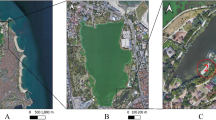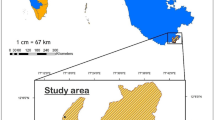Abstract
We monitored 20 cape foxes (Vulpes chama) to determine the social organization, survival, and dispersal of this species on two sites in South Africa from 2005 to 2008. Cape foxes were socially monogamous and territorial, with annual home ranges of mated pairs (n = 8) overlapping 80% on average, compared to a mean overlap of 3% between foxes in adjacent ranges. At least 2 pairs remained associated for >1 breeding season, and both sexes exhibited strong site fidelity, as home ranges in consecutive years overlapped 58-98%. Members of mated pairs never foraged together, however they used the same or nearby (<100 m apart) day rests 81% of the time when pups were 0–4 months of age, but only 28% of the time during other months of the year. Dispersal was male biased, as all juvenile males (n = 6) dispersed when 9–11.5 months old, whereas 3 of 4 juvenile females remained philopatric as either breeders or non-breeding associates. At least 6 foxes bred as yearlings (3 F, 3 M), indicating cape foxes have high reproductive potential. Two adult females maintained their territories after their mates died, whereas two adult males dispersed soon after their mates died, indicating cape foxes likely have a female-based social organization. Annual survival was 0.64, and predation from larger carnivores, primarily black-backed jackals (Canis mesomelas), was responsible for 71% of mortalities. Our results provided empirical support for previous hypotheses regarding the relationship between body size and life-history patterns in Canidae, as several ecological parameters of cape foxes were similar to that of other small (<6 kg) canid species, especially Vulpes species inhabiting arid and semi-arid environments.
Similar content being viewed by others
References
Bester, J.L., 1982. Die gedragsekologie en bestuur van die silwervos Vulpes chama (A. Smith, 1833) met spesiale verwysing na die Oranje-Vrystaat. University of Pretoria, South Africa (Master’s Thesis).
Cameron, C, Berteaux, D., Dufresne, F., 2011. Spatial variation in food availability predicts extrapair paternity in the arctic fox. Behav. Ecol. 22, 1364–1373.
Cavallini, P., 1996. Variation in the social system of the red fox. Ethol. Ecol. Evol. 8, 23–342.
Clark Jr., H.O., Murdoch, J.D., Newman, D.P., Sillero-Zubiri, C, 2009. Vulpes corsac. Mamm. Species 832, 1–8.
Clark Jr., H.O., Newman, D.P., Murdoch, J.D., Tseng, J., Wang, Z.H., Harris, R.B., 2008. Vulpes ferrilata. Mamm. Species 821, 1–6.
Cole, L.C., 1949. The measurement of interspecific association. Ecology 30, 411–424.
Cypher, B.L., Warrick, G.D., Otten, M.R.M., O’Farrell, T.P., Berry, W.H., Harris, C.E., Kato, T.T., McCue, P.M., Scrivner, J.H., Zoellick, B.W., 2000. Population dynamics of San Joaquin kit foxes at the Naval Petroleum Reserves in California. Wildl. Monogr. 145, 1–43.
Dobson, F.S., Jones, W.T., 1985. Multiple causes of dispersal. Am. Nat. 126, 855–858.
Fritts, S.H., Mech, L.D., 1981. Dynamics, movements, and feeding ecology of a newly protected wolf population in northwestern Minnesota. Wildl. Monogr. 80, 1–79.
Geffen, E., Gompper, M.E., Gittleman, J.L., Luh, H.K., Macdonald, D.W., Wayne, R.K., 1996. Size, life-history traits, and social organization in the Canidae: a reevaluation. Am. Nat. 147, 140–160.
Geffen, E., Macdonald, D.W., 1992. Small size and monogamy: spatial organization of Blanford’s foxes, Vulpes cana. Anim. Behav. 44, 1123–1130.
Geffen, E., Mercure, A., Girman, D.J., Macdonald, D.W., Wayne, R.K., 1992. Phylogenetic relationships of the fox-like canids: mitochondrial DNA restriction fragment, site and cytochrome b sequence analyses. J. Zool. Lond. 228, 27–39.
Ginsberg, J.R., Macdonald, D.W., 1990. Foxes, Wolves, Jackals, and Dogs: An Action Plan for the Conservation of Canids. IUCN/SSC Canid Specialist Group, Gland, Switzerland.
Gosselink, T.E., Piccolo, K.A., Van Deelen, T.R., Warner, R.E., Mankin, P.C., 2010. Natal dispersal and philopatry of red foxes in urban and agricultural areas of Illinois. J. Wildl. Manage. 74, 1204–1217.
Heisey, D.M., Fuller, T.K., 1985. Evaluation of survival and cause-specific mortality rates using telemetry data. J. Wildl. Manage. 49, 668–674.
Hennessy, C.A., Dubach, J., Gehrt, S.D., 2012. Long-term pair bonding and genetic evidence for monogamy among urban coyotes (Canis latrans). J. Mammal. 93, 732–742.
Hersteinsson, P., Macdonald, D.W., 1982. Some comparisons between red and arctic foxes, Vulpes vulpes and Alopex lagopus, as revealed by radio tracking. Symp. Zool. Soc. Lond. 49, 259–289.
Iossa, G., Soulsbury, CD., Baker, P.J., Harris, S., 2008. Body mass, territory size, and life-history tactics in a socially monogamous canid, the red fox Vulpes vulpes. J. Mammal. 89, 1481–1490.
Johnsingh, A.J.T., Jhala, Y.V., 2004. Indian fox. In: Sillero-Zubiri, C, Hoffmann, M., Macdonald, D.W. (Eds.), Canids: Foxes, Wolves, Jackals and Dogs. Status Survey and Conservation Action Plan. IUCN/SSC Canid Specialist Group, Gland, Switzerland, pp. 219–222.
Kamler, J.F., Ballard, W.B., Gilliland, R.L., Lemons, P.R., Mote, K., 2003. Impacts of coyotes on swift foxes in northwestern Texas. J. Wildl. Manage. 67, 317–323.
Kamler, J.F., Ballard, W.B., Gese, E.M., Harrison, R.L., Karki, S.M., 2004a. Dispersal characteristics of swift foxes. Can. J. Zool. 82, 1837–1842.
Kamler, J.F., Ballard, W.B., Gese, E.M., Harrison, R.L., Karki, S.M., Mote, K., 2004b. Adult male emigration and a female-based social organisation in swift foxes, Vulpes velox. Anim. Behav. 67, 699–702.
Kamler, J.F., Ballard, W.B., Lemons, P.R., Mote, K., 2004c. Variation in the mating system and group structure in two populations of swift foxes, Vulpes velox. Anim. Behav. 68, 83–88.
Kamler, J.F., Stenkewitz, U., Klare, U., Jacobsen, N.F., Macdonald, D.W., 2012. Resource partitioning among cape foxes, bat-eared foxes, and black-backed jackals in South Africa. J. Wildl. Manage. 76, 1241–1253.
Kamler, J.F., Stenkewitz, U., Macdonald, D.W., 2013. Lethal and sublethal effects of black-backed jackals on cape foxes and bat-eared foxes. J. Mammal. 94, 295–306.
Kernohan, B.J., Gitzen, R.A., Millspaugh, J.J., 2001. Analysis of animal space use and movements. In: Millspaugh, J.J., Marzluff, J.M. (Eds.), Radio Tracking and Animal Populations. Academic Press, San Diego, pp. 126–168.
Kitchen, A.M., Gese, E.M., Schauster, E.R., 1999. Resource partitioning between coyotes and swift foxes: space, time, and diet. Can. J. Zool. 77, 1645–1656.
Kitchen, A.M., Gese, E.M., Karki, S.M., Schauster, E.R., 2005. Spatial ecology of swift fox social groups: from group formation to mate loss. J. Mammal. 86, 547–554.
Kleiman, D.G., 1977. Monogamy in mammals. Q. Rev. Biol. 52, 39–69.
Kleiman, D.G., Eisenberg, J.F., 1973. Comparisons of canid and felid social systems from an evolutionary perspective. Anim. Behav. 21, 637–659.
Koopman, M.E., Cypher, B.L., Scrivner, J.H., 2000. Dispersal patterns of San Joaquin kit foxes (Vulpes macrotis mutica).J. Mammal. 81, 213–222.
Lariviere, S., Seddon, P.J., 2001. Vulpes rueppelli. Mamm. Species 678, 1–5.
Lindsay, I.M., Macdonald, D.W., 1986. Behaviour and ecology of the Ruppell’s fox, Vulpes ruppelli, in Oman. Mammalia 50, 461–474.
Maas, B., Macdonald, D.W., 2004. Bat-eared foxes. In: Macdonald, D.W., Sillero-Zubiri, C. (Eds.), The Biology and Conservation of Wild Canids. Oxford University Press, Oxford, United Kingdom, pp. 227–242.
Macdonald, D.W., Courtenay, O., Forbes, S., Mathews, F., 1999. The red fox (Vulpes vulpes) in Saudi Arabia: loose-knit groupings in the absence of territoriality. J. Zool. Lond. 249, 383–391.
Macdonald, D.W., Reynolds, J.C., 2004. Red fox. In: Sillero-Zubiri, C, Hoffmann, M., Macdonald, D.W. (Eds.), Canids: Foxes, Wolves, Jackals and Dogs. Status Survey and Conservation Action Plan. IUCN/SSC Canid Specialist Group, Gland, Switzerland, pp. 129–136.
Macdonald, D.W., Creel, S., Mills, M.G.L., 2004. Society. In: Macdonald, D.W., Sillero-Zubiri, C. (Eds.), The Biology and Conservation of Wild Canids. Oxford University Press, Oxford, United Kingdom, pp. 85–106.
Moehlman, P. D., 1986. Ecology and cooperation in canids. In: Rubenstein, D.I., Wrangham, R.W. (Eds.), Ecological Aspects of Social Evolution: Birds and Mammals. Princeton, University Press, Princeton, New Jersey, pp. 64–86.
Moehlman, P.D., 1989. Intraspecific variation in canid social systems. In: Gittleman, J.L. (Ed.), Carnivore Behavior, Ecology, and Evolution, vol. 1. Cornell University Press, Ithaca, New York, pp. 143–163.
Moehlman, P.D., Hofer, H., 1997. Cooperative breeding, reproductive suppression, and body mass in canids. In: Solomon, N.G., French, J.A. (Eds.), Cooperative Breeding in Mammals. Cambridge University Press, Cambridge, United Kingdom, pp. 76–128.
Moehrenschlager, A., Sovada, M., 2004. Swift fox. In: Sillero-Zubiri, C, Hoffmann, M., Macdonald, D.W. (Eds.), Canids: Foxes, Wolves, Jackals and Dogs. Status Survey and Conservation Action Plan. IUCN/SSC Canid Specialist Group, Gland, Switzerland, pp. 109–116.
Morrell,S., 1972. Life history of the San Joaquin kit fox. Calif. Fish Game 58, 162–174.
Murdoch, J.D., Munkhzul, T., Buyandelger, S., Reading, R.P., 2009. Body size and sexual dimorphism among a population of corsac and red foxes in central Mongolia. Mammalia 73, 72–75.
Murdoch, J.D., Munkhzul, T., Buyandelger, S., Sillero-Zubiri, C, 2010. Survival and cause-specific mortality of corsac and red foxes in Mongolia. J. Wildl. Manage. 74, 59–64.
Nel, J.AJ., 1984. Behavioural ecology of canids in the southwestern Kalahari. Koedoe 27 (Suppl.), 229–235.
Pusey, A.E., 1987. Sex-biased dispersal and inbreeding avoidance in birds and mammals. Trends Ecol. Evol. 2, 295–299.
Ralls, K., White, P.J., 1995. Predation on San Joaquin kit foxes by larger canids. J. Mammal. 76, 723–729.
Ralls, K., Cypher, B., Spiegel, LA., 2007. Social monogamy in kit foxes: formation, association, duration, and dissolution of mated pairs. J. Mammal. 88, 1439–1446.
Schauster, E.R., Gese, E.M., Kitchen, A.M., 2002. Population ecology of swift foxes (Vulpes velox) in southeastern Colorado. Can. J. Zool. 80, 307–319.
Shivik, J.A., Gese, E.M., 2000. Territorial significance of home range estimators for coyotes. Wildl. Soc. Bull. 28, 940–946.
Sikes, R.S., Gannon, W.L., The Animal Care and Use Committee of the American Society of Mammalogists, 2011. Guidelines ofthe American Society of Mammalogists for the use of wild mammals in research. J. Mammal. 92, 235–253.
Skinner, J.D., Chimimba, C.T., 2005. The Mammals ofthe Southern African Subregion. Cambridge University Press, Cambridge, United Kingdom.
Sliwa, A., 1996. A Functional Analysis of Scent Marking and Mating Behaviour in the Aardwolf Proteles cristatus (Sparrman, 1783). University of Pretoria, South Africa (Ph.D. Thesis).
Smithers, R.H.N., 1971. The mammals of Botswana. Mus. Mem. Nat. Mus. Rhod. 4, 1–340.
Stuart, C, Stuart, T., 2004. Cape fox. In: Sillero-Zubiri, C, Hoffmann, M., Macdonald, D.W. (Eds.), Canids: Foxes, Wolves, Jackals and Dogs. Status Survey and Conservation Action Plan. IUCN/SSC Canid Specialist Group, Gland, Switzerland, pp. 189–193.
Voigt, D.R., Macdonald, D.W., 1984. Variation in the spatial and social behaviour of the red fox, Vulpes vulpes. Acta Zool. Fenn. 171, 261–265.
vonSchantz, T., 1984. ‘Non-breeders’ in the red fox Vulpes vulpes: a case of resource surplus. Oikos 42, 59–65.
Waser, P.M., Jones, W.T., 1983. Natal philopatry among solitary mammals. Q. Rev. Biol. 58, 355–390.
White, P.J., Ralls, K., 1993. Reproduction and spacing patterns of kit foxes relative to changing prey availability. J. Wildl. Manage. 57, 861–867.
White, P.J., Ralls, K., Sniff, D.B., 2000. Nocturnal encounters between kit foxes. J. Mammal. 81, 456–461.
Zabel, C.J.,Taggart, S.J., 1989. Shift in red fox, Vulpes vulpes, mating system associated with El Nino in the Bering Sea. Anim. Behav. 38, 830–838.
Author information
Authors and Affiliations
Corresponding author
Additional information
by Adriano Martinoli
Rights and permissions
About this article
Cite this article
Kamler, J.F., Macdonald, D.W. Social organization, survival, and dispersal of cape foxes (Vulpes chama) in South Africa. Mamm Biol 79, 64–70 (2014). https://doi.org/10.1016/j.mambio.2013.09.004
Received:
Accepted:
Published:
Issue Date:
DOI: https://doi.org/10.1016/j.mambio.2013.09.004




